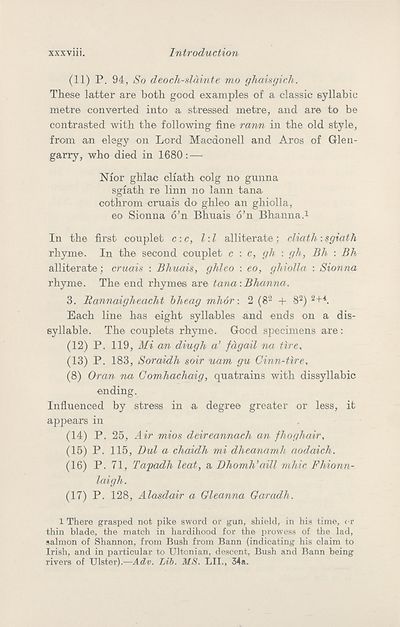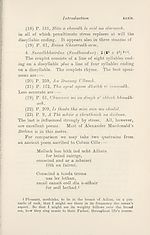Download files
Complete book:
Individual page:
Thumbnail gallery: Grid view | List view

Introduction
xxxviii.
(11) P. 94, So deoch-sldinte mo ghaisgich.
These latter are both good examples of a classic syllabic
metre converted into a stressed metre, and are to be
contrasted with the following fine rann in the old style,
from an elegy on Lord Maodonell and Aros of Glen¬
garry, who died in 1680: —
Nfor ghlac cliath colg no gunna
sgiath re linn no lann tana
cothrom cruais do ghleo an ghiolla,
eo Sionna 6’n Bhuais 6’n Bhanna.1
In the first couplet c : c, l .l alliterate ; cliath : sgiath
rhyme. In the second couplet c : c, gh : gh, Bh : Bh
alliterate; cruais : Bhuais, ghleo : eo, ghiolla : Sionna
rhyme. The end rhymes are tana: Bhanna.
3. Rannaigheacht hheag mhor\ 2 (82 + 82) 2+*.
Each line has eight syllables and ends on a dis¬
syllable. The couplets rhyme. Good specimens are :
(12) P. 119, Mi an diugh a’ fdgail na tire,
(13) P. 183, Soraidh soir uam gu Cinn-tire,
(8) Oran na Comhachaig, quatrains with dissyllabic
ending.
Influenced by stress in a degree greater or less, it
appears in
(14) P. 25, Air mios deireannach an fhoghair,
(15) P. 115, Dul a chaidh mi dheanamh aodaich.
(16) P. 71, Tapadh leal, a Dhomh’aill mhic Fhionn-
laigh.
(17) P. 128, Alasdair a Gleanna Garadh.
1 There grasped not pike sword or gun, shield, in his time, or
thin blade, the match in hardihood for the prowess of the lad,
salmon of Shannon, from Bush from Bann (indicating his claim to
Irish, and in particular to Ultonian, descent, Bush and Bann being
rivers of Ulster).—Adv. Lib. MS. LIL, 34a.
xxxviii.
(11) P. 94, So deoch-sldinte mo ghaisgich.
These latter are both good examples of a classic syllabic
metre converted into a stressed metre, and are to be
contrasted with the following fine rann in the old style,
from an elegy on Lord Maodonell and Aros of Glen¬
garry, who died in 1680: —
Nfor ghlac cliath colg no gunna
sgiath re linn no lann tana
cothrom cruais do ghleo an ghiolla,
eo Sionna 6’n Bhuais 6’n Bhanna.1
In the first couplet c : c, l .l alliterate ; cliath : sgiath
rhyme. In the second couplet c : c, gh : gh, Bh : Bh
alliterate; cruais : Bhuais, ghleo : eo, ghiolla : Sionna
rhyme. The end rhymes are tana: Bhanna.
3. Rannaigheacht hheag mhor\ 2 (82 + 82) 2+*.
Each line has eight syllables and ends on a dis¬
syllable. The couplets rhyme. Good specimens are :
(12) P. 119, Mi an diugh a’ fdgail na tire,
(13) P. 183, Soraidh soir uam gu Cinn-tire,
(8) Oran na Comhachaig, quatrains with dissyllabic
ending.
Influenced by stress in a degree greater or less, it
appears in
(14) P. 25, Air mios deireannach an fhoghair,
(15) P. 115, Dul a chaidh mi dheanamh aodaich.
(16) P. 71, Tapadh leal, a Dhomh’aill mhic Fhionn-
laigh.
(17) P. 128, Alasdair a Gleanna Garadh.
1 There grasped not pike sword or gun, shield, in his time, or
thin blade, the match in hardihood for the prowess of the lad,
salmon of Shannon, from Bush from Bann (indicating his claim to
Irish, and in particular to Ultonian, descent, Bush and Bann being
rivers of Ulster).—Adv. Lib. MS. LIL, 34a.
Set display mode to:
![]() Universal Viewer |
Universal Viewer | ![]() Mirador |
Large image | Transcription
Mirador |
Large image | Transcription
| An Comunn Gàidhealach > An Comunn Gàidhealach Publications > Bàrdachd Ghàidhlig > (42) |
|---|
| Permanent URL | https://digital.nls.uk/126455522 |
|---|
| Description | This contains items published by An Comunn, which are not specifically Mòd-related. It includes journals, annual reports and corporate documents, policy statements, educational resources and published plays and literature. It is arranged alphabetically by title. |
|---|
| Description | A collection of over 400 items published by An Comunn Gàidhealach, the organisation which promotes Gaelic language and culture and organises the Royal National Mòd. Dating from 1891 up to the present day, the collection includes journals and newspapers, annual reports, educational materials, national Mòd programmes, published Mòd literature and music. |
|---|---|
| Additional NLS resources: |
|

